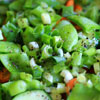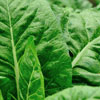Melt the butter in a large skillet over medium heat. Add the quartered fennel bulbs; cook and stir until golden brown, about 10 minutes. Pour in the broth, and simmer until fennel is tender, about 15 more minutes. Add the pureed potatoes and mix well. Ladle into soup bowls, and season with salt and pepper. Garnish with fennel fronds just before serving. Makes 4 servings.



